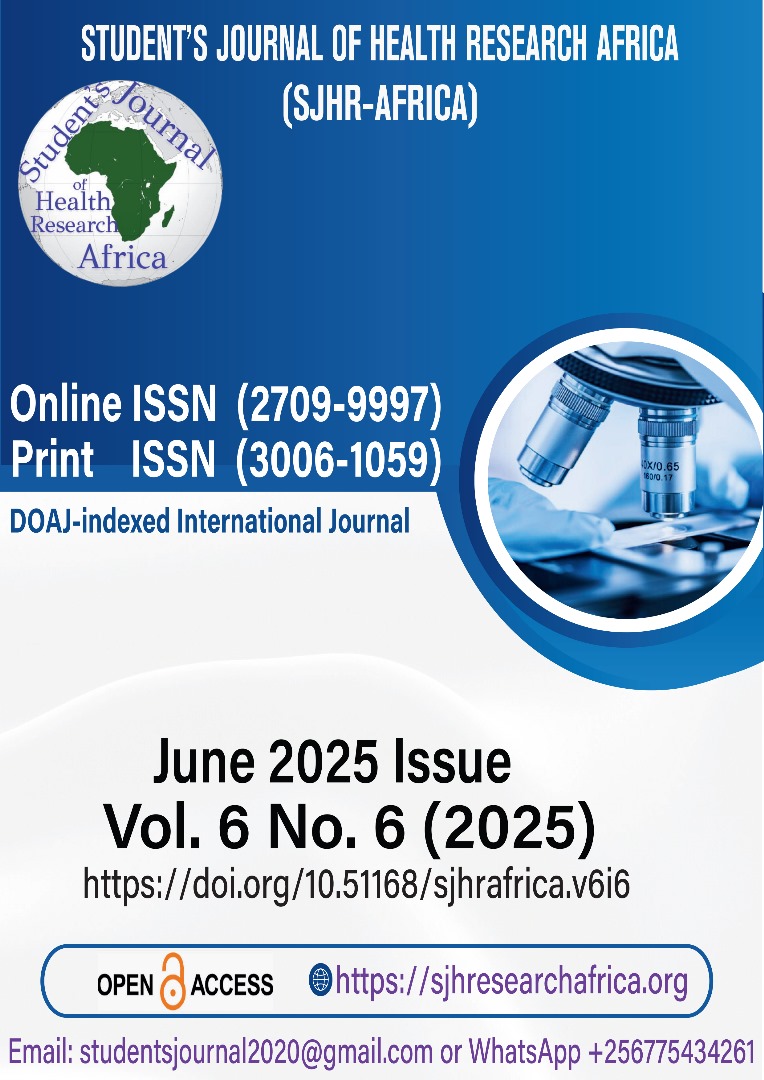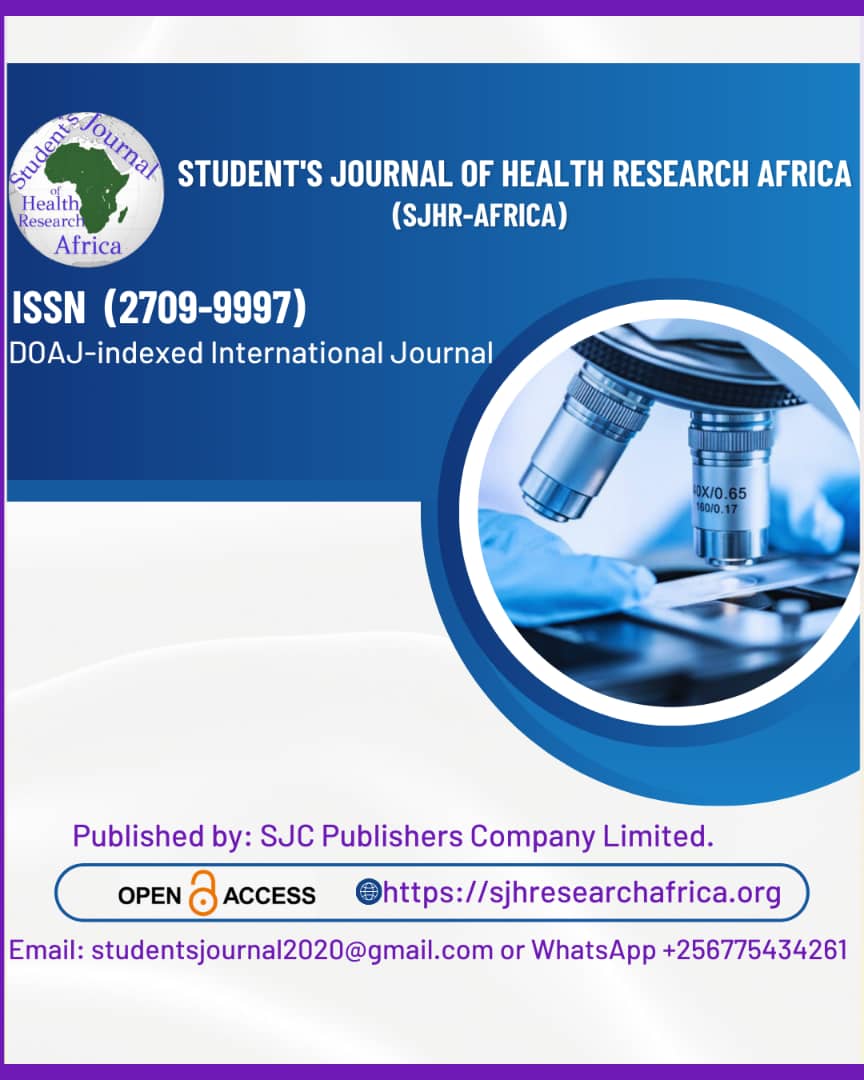INDIVIDUAL FACTORS ASSOCIATED WITH UTILIZATION OF HIV SELF-TESTING SERVICES AMONG ADOLESCENT GIRLS AND YOUNG WOMEN BETWEEN 15-24 YEARS IN IGANGA DISTRICT-UGANDA
INDIVIDUAL FACTORS ASSOCIATED WITH UTILIZATION OF HIV SELF-TESTING SERVICES
DOI:
https://doi.org/10.51168/sjhrafrica.v6i6.1617Keywords:
Utilization, HIV, Self-testing, Adolescents, young women, UgandaAbstract
Introduction: The uptake of HIV testing services is sub-optimal among adolescent girls and young women. HIV self-testing offers opportunities to improve the uptake of HIV testing services among adolescent girls and young women. The study was conducted to determine individual factors associated with the utilization of HIV self-testing services among adolescent girls and young women between 15-24 years in Iganga District.
Methods: The study was a cross-sectional design. Research questionnaires were administered to collect data. A total of 384 adolescent girls and young women between 15-24 years were interviewed. Logistic regression analysis was used to determine the factors associated with HIV self-testing and odds ratio was used as a measure of association.
Results: The response of the study was 100% and 16.7% of the respondents have ever tested for HIV using HIVST services. The study found that 64.1% of the respondents were aged 20-24 years, 48.2% had primary education, 51.6% were never married and 28.6% were housewives. HIV self-testing was significantly associated with secondary education (AOR: 4.267, 95% CI: 1.310-13.898, P=0.016), having ever heard about HIVST (AOR: 3.406, 95% CI: 1.497-7.749, P-0.003), knowing how to use the HIVST (AOR: 3.161, 95% CI: 1.463-6.827, P-0.003), discrimination in the community because of HIV status (AOR: 5.595, 95% CI: 1.595-20.379, P-0.009), ever been diagnosed with STIs (AOR: 0.266, 95% CI: 0.107-0.663, P-0.004) and having two sexual partners (AOR: 4.415, 95% CI: 1.303-14.962, P-0.017).
Conclusion: The study demonstrates levels of utilization of HIV self-testing among adolescent girls and young women in association with a number of factors that include education level, knowledge on HIVST, stigmatization, history of STIs, number of sexual partners, and accessibility of the services. An enhancement of educational and awareness programs on HIV self-testing (HIVST) was recommended.
References
Asiimwe, S., Oloya, J., Song, X., Whalen, C. C., & Accuracy of Un-supervised, Visual HIV Self-Test : A Systematic Review. (2017). Accuracy of Un-supervised, Visual HIV Self-Test : A Systematic Review. Open AIDS Journal, 11(1), 58–61.
Baral, R., Tsampasian, V., Debski, M., Moran, B., Garg, P., Clark, A., & Vassiliou, V. S. (2021). Association between renin-angiotensin-aldosterone system inhibitors and clinical outcomes in patients with COVID-19: a systematic review and meta-analysis. JAMA network Open, 4(3), e213594-e213594.
Chanda, M. M., Ortblad, K. F., Mwale, M., Chongo, S., Kanchele, C., Kamungoma, N., ... & Oldenburg, C. E. (2017). HIV self-testing among female sex workers in Zambia: a cluster randomized controlled trial. PLoS medicine, 14(11), e1002442.
Choko, A., Kumwenda, M., Fielding, K., Corbett, E., Chikovore, J., Desmond, N. (2016). Acceptability of woman-delivered HIV self-testing to the male partner: a qualitative study of antenatal clinic-linked participants in Blantyre, Malawi. Presented at: 21st International AIDS Conference;18-22 July; Durban, South Africa.
Hensen, B., Phiri, M., Schaap, A., Sigande, L., Simwinga, M., Floyd, S., ... & Ayles, H. M. (2021). Uptake of HIV Testing Services Through Novel Community-Based Sexual and Reproductive Health Services: An Analysis of the Pilot Implementation Phase of the Yathu Yathu Intervention for Adolescents and Young People Aged 15–24 in Lusaka, Zambia. AIDS and Behavior, 1-11.
Indravudh, P. P., Sibanda, E. L., d’Elbée, M., Kumwenda, M. K., Ringwald, B., Maringwa, G., ... & Taegtmeyer, M. (2017). ‘I will choose when to test, where I want to test’: investigating young people's preferences for HIV self-testing in Malawi and Zimbabwe. Aids, 31, S203-S212.
Kelvin, E. A., Cheruvillil, S., Christian, S., Mantell, J. E., Milford, C., Rambally-Greener, L., ... & Smit, J. A. (2016). Choice in HIV testing: the acceptability and anticipated use of a self-administered at-home oral HIV test among South Africans. African Journal of AIDS Research, 15(2), 99-108.
Lippman, S. A., Lane, T., Rabede, O., Gilmore, H., Chen, Y. H., Mlotshwa, N., ... & McIntyre, J. A. (2018). High acceptability and increased HIV-testing frequency after introduction of HIV self-testing and network distribution among South African MSM. JAIDS Journal of Acquired Immune Deficiency Syndromes, 77(3), 279-287.
Matovu, J. K. B., Kisa, R., Buregyeya, E., Chemusto, H., Mugerwa, S., Musoke, W., ... & Wanyenze, R. K. (2018). 'If I had not taken it [HIVST kit] home, my husband would not have come to the facility to test for HIV': HIV self-testing perceptions, delivery strategies, and post-test experiences among pregnant women and their male partners in Central Uganda. Global Health Action, 11(1), 1503784.
Matovu, J. K. B., Kisa, R., Buregyeya, E., Chemusto, H., Mugerwa, S., Musoke, W., ... & Wanyenze, R. K. (2018). 'If I had not taken it [HIVST kit] home, my husband would not have come to the facility to test for HIV': HIV self-testing perceptions, delivery strategies, and post-test experiences among pregnant women and their male partners in Central Uganda. Global Health Action, 11(1), 1503784.
Musoke, D., Ssemugabo, C., Kasasa, S., Ssekamatte, T., Okello, D., Gibson, L., & Ndejjo, R. (2018). Prevalence of HIV self-testing among young women in Uganda. African Health Sciences, 18(4), 919-928. https://doi.org/10.4314/ahs.v18i4.10
Ngure, K., Heffron, R., Mugo, N., Thomson, K.A., Irungu, E., Njuguna, N. (2018). Feasibility and acceptability of HIV self-testing among pre-exposure prophylaxis users in Kenya. J Int AIDS Soc. 20(1):21234.
Njau, B., Covin, C., Lisasi, E., Damian, D., Mushi, D., Boulle, A., & Mathews, C. (2019). A systematic review of qualitative evidence on factors enabling and deterring uptake of HIV self-testing in Africa. BMC public health, 19, 1-16.
Nuwabaine, L., Kawuki, J., Namulema, A., Asiimwe, J. B., Sserwanja, Q., Gatasi, G., & Donkor, E. (2024). Factors associated with HIV testing among pregnant women in Rwanda: A nationwide cross-sectional survey. PLOS Global Public Health, 4(1), e0002728.
Ortblad, K. F., Musoke, D. K., Ngabirano, T., Nakitende, A., Taasi, G., Barresi, L. G., ... & Oldenburg, C. E. (2018). HIV self-test performance among female sex workers in Kampala, Uganda: a cross-sectional study. BMJ open, 8(11), e022652.
Pant Pai, N., Sharma, J., Shivkumar, S., Pillay, S., Vadnais, C., Joseph, L., & Dheda, K. (2013). Supervised and unsupervised self-testing for HIV in high- and low-risk populations: A systematic review. PLoS Medicine, 10(4), e1001414. https://doi.org/10.1371/journal.pmed.1001414
Shannon, K., Strathdee, S. A., Goldenberg, S. M., Duff, P., Mwangi, P., Rusakova, M., ... & Boily, M. C. (2015). Global epidemiology of HIV among female sex workers: influence of structural determinants. The Lancet, 385(9962), 55-71.
Ssebunya, R. N., Wanyenze, R. K., Namale, L., Lukolyo, H., Kisitu, G. P., Nahirya-Ntege, P., & Kekitiinwa, A. (2018). Prevalence and correlates of HIV testing among adolescents 10–19 years in a post-conflict pastoralist community of Karamoja region, Uganda. BMC public health, 18, 1-8.
WHO. (2017). Guideline on when to start antiretroviral therapy and on pre-exposure prophylaxis for HIV. Geneva: World Health Organization.
WHO. (2018). WHO recommendations on HIV self-testing.
Published
How to Cite
Issue
Section
License
Copyright (c) 2025 Abdulmujeeb Babatunde Aremu, Zikula , Mwebaza Muluya, Rashid, Zziwa

This work is licensed under a Creative Commons Attribution-NonCommercial-NoDerivatives 4.0 International License.






















